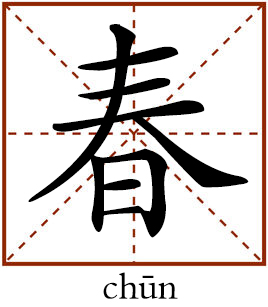Spring

This character refers to spring, a season when new life starts. In Chinese literature and arts, spring is the promise that everything can begin again, letting go and embracing something new. For instance, chunyu, or the spring rain, is often considered the rain of rebirth that makes the cold and dark dwindle away and promises a good harvest for the year.
春风送暖入屠苏
chūn fēng sòng nuǎn rù tú sū
Chun feng refers to the wind in spring and nuan refers to warmth. Tusu is a name of a liquor made from the tusu plant, in some places it is drunk on Chinese New Year’s Day. This verse literally means that the wind in spring warms the tusu drink. It is a vivid description of a refreshing New Year’s Day.
This is a verse from a poem titled “New Year’s Day” by Wang Anshi (1021–1086), a credited poet and a governmental reformer of the Song Dynasty. “In the midst of firecrackers goes the old year,/ And spring breeze lends warmth to the tusu wine./ At countless doors new peachwood charms appear in place of the old,/ the world bathed in the sunshine.” The poem depicts how the Song people celebrated the Spring Festival on the first day of the New Year with references to several customs at that time. One notable custom was to drink the tusu liquor one by one from the youngest to the oldest family member, then wrap the dregs in red cloth and hang it on the doorframe as a preventive against illness. Replacing the old peachwood charm with a new one was another important custom. The peachwood charm was painted with demons hung over doors to ward off evil spirits. It is said that the pair of scrolls pasted on sides of doors, known as the spring couplets, originates from the peachwood charm.
Wang is best known for his major and controversial socioeconomic reforms known as the “New Laws” or “New Policies” in the Northern Song Dynasty. It is said that the cheerful and positive mood conveyed from the poem reflects Wang’s ambition and excitement to implement his unconventional idealism through the “New Policies.” Replacing the old peachwood charm can be seen as a metaphor for improving the backwardness of bureaucracy, and the sunshine of the New Year’s Day symbolizes his confidence to give the country a promising future through the reform.
(edited by REN GUANHONG)

 PRINT
PRINT CLOSE
CLOSE